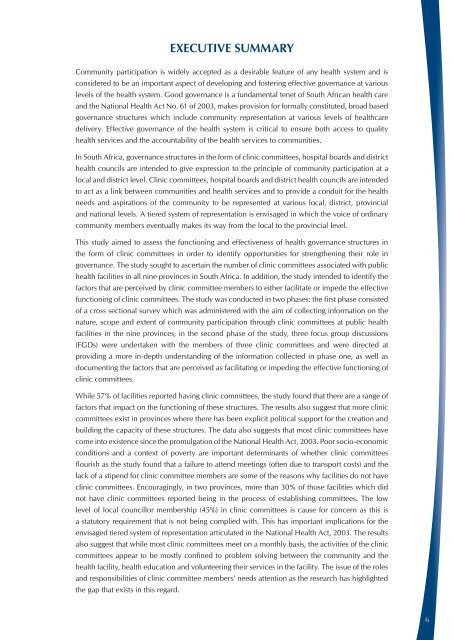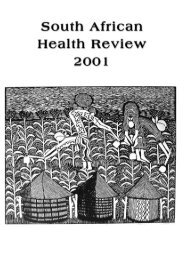The Status of Clinic Committees in Primary Level - Health Systems ...
The Status of Clinic Committees in Primary Level - Health Systems ...
The Status of Clinic Committees in Primary Level - Health Systems ...
You also want an ePaper? Increase the reach of your titles
YUMPU automatically turns print PDFs into web optimized ePapers that Google loves.
EXECUTIVE SUMMARY<br />
Community participation is widely accepted as a desirable feature <strong>of</strong> any health system and is<br />
considered to be an important aspect <strong>of</strong> develop<strong>in</strong>g and foster<strong>in</strong>g effective governance at various<br />
levels <strong>of</strong> the health system. Good governance is a fundamental tenet <strong>of</strong> South African health care<br />
and the National <strong>Health</strong> Act No. 61 <strong>of</strong> 2003, makes provision for formally constituted, broad based<br />
governance structures which <strong>in</strong>clude community representation at various levels <strong>of</strong> healthcare<br />
delivery. Effective governance <strong>of</strong> the health system is critical to ensure both access to quality<br />
health services and the accountability <strong>of</strong> the health services to communities.<br />
In South Africa, governance structures <strong>in</strong> the form <strong>of</strong> cl<strong>in</strong>ic committees, hospital boards and district<br />
health councils are <strong>in</strong>tended to give expression to the pr<strong>in</strong>ciple <strong>of</strong> community participation at a<br />
local and district level. <strong>Cl<strong>in</strong>ic</strong> committees, hospital boards and district health councils are <strong>in</strong>tended<br />
to act as a l<strong>in</strong>k between communities and health services and to provide a conduit for the health<br />
needs and aspirations <strong>of</strong> the community to be represented at various local, district, prov<strong>in</strong>cial<br />
and national levels. A tiered system <strong>of</strong> representation is envisaged <strong>in</strong> which the voice <strong>of</strong> ord<strong>in</strong>ary<br />
community members eventually makes its way from the local to the prov<strong>in</strong>cial level.<br />
This study aimed to assess the function<strong>in</strong>g and effectiveness <strong>of</strong> health governance structures <strong>in</strong><br />
the form <strong>of</strong> cl<strong>in</strong>ic committees <strong>in</strong> order to identify opportunities for strengthen<strong>in</strong>g their role <strong>in</strong><br />
governance. <strong>The</strong> study sought to ascerta<strong>in</strong> the number <strong>of</strong> cl<strong>in</strong>ic committees associated with public<br />
health facilities <strong>in</strong> all n<strong>in</strong>e prov<strong>in</strong>ces <strong>in</strong> South Africa. In addition, the study <strong>in</strong>tended to identify the<br />
factors that are perceived by cl<strong>in</strong>ic committee members to either facilitate or impede the effective<br />
function<strong>in</strong>g <strong>of</strong> cl<strong>in</strong>ic committees. <strong>The</strong> study was conducted <strong>in</strong> two phases: the first phase consisted<br />
<strong>of</strong> a cross sectional survey which was adm<strong>in</strong>istered with the aim <strong>of</strong> collect<strong>in</strong>g <strong>in</strong>formation on the<br />
nature, scope and extent <strong>of</strong> community participation through cl<strong>in</strong>ic committees at public health<br />
facilities <strong>in</strong> the n<strong>in</strong>e prov<strong>in</strong>ces; <strong>in</strong> the second phase <strong>of</strong> the study, three focus group discussions<br />
(FGDs) were undertaken with the members <strong>of</strong> three cl<strong>in</strong>ic committees and were directed at<br />
provid<strong>in</strong>g a more <strong>in</strong>-depth understand<strong>in</strong>g <strong>of</strong> the <strong>in</strong>formation collected <strong>in</strong> phase one, as well as<br />
document<strong>in</strong>g the factors that are perceived as facilitat<strong>in</strong>g or imped<strong>in</strong>g the effective function<strong>in</strong>g <strong>of</strong><br />
cl<strong>in</strong>ic committees.<br />
While 57% <strong>of</strong> facilities reported hav<strong>in</strong>g cl<strong>in</strong>ic committees, the study found that there are a range <strong>of</strong><br />
factors that impact on the function<strong>in</strong>g <strong>of</strong> these structures. <strong>The</strong> results also suggest that more cl<strong>in</strong>ic<br />
committees exist <strong>in</strong> prov<strong>in</strong>ces where there has been explicit political support for the creation and<br />
build<strong>in</strong>g the capacity <strong>of</strong> these structures. <strong>The</strong> data also suggests that most cl<strong>in</strong>ic committees have<br />
come <strong>in</strong>to existence s<strong>in</strong>ce the promulgation <strong>of</strong> the National <strong>Health</strong> Act, 2003. Poor socio-economic<br />
conditions and a context <strong>of</strong> poverty are important determ<strong>in</strong>ants <strong>of</strong> whether cl<strong>in</strong>ic committees<br />
flourish as the study found that a failure to attend meet<strong>in</strong>gs (<strong>of</strong>ten due to transport costs) and the<br />
lack <strong>of</strong> a stipend for cl<strong>in</strong>ic committee members are some <strong>of</strong> the reasons why facilities do not have<br />
cl<strong>in</strong>ic committees. Encourag<strong>in</strong>gly, <strong>in</strong> two prov<strong>in</strong>ces, more than 30% <strong>of</strong> those facilities which did<br />
not have cl<strong>in</strong>ic committees reported be<strong>in</strong>g <strong>in</strong> the process <strong>of</strong> establish<strong>in</strong>g committees. <strong>The</strong> low<br />
level <strong>of</strong> local councillor membership (45%) <strong>in</strong> cl<strong>in</strong>ic committees is cause for concern as this is<br />
a statutory requirement that is not be<strong>in</strong>g complied with. This has important implications for the<br />
envisaged tiered system <strong>of</strong> representation articulated <strong>in</strong> the National <strong>Health</strong> Act, 2003. <strong>The</strong> results<br />
also suggest that while most cl<strong>in</strong>ic committees meet on a monthly basis, the activities <strong>of</strong> the cl<strong>in</strong>ic<br />
committees appear to be mostly conf<strong>in</strong>ed to problem solv<strong>in</strong>g between the community and the<br />
health facility, health education and volunteer<strong>in</strong>g their services <strong>in</strong> the facility. <strong>The</strong> issue <strong>of</strong> the roles<br />
and responsibilities <strong>of</strong> cl<strong>in</strong>ic committee members’ needs attention as the research has highlighted<br />
the gap that exists <strong>in</strong> this regard.<br />
6
















